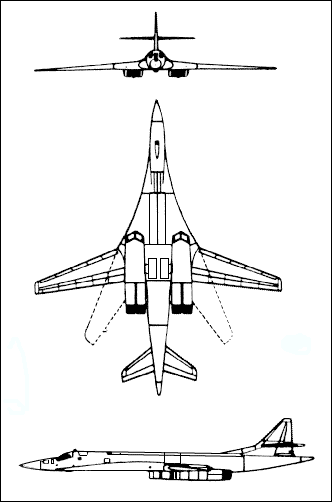HISTORY:
First Flight 19 December 1981
Service Entry
25 April 1987
CREW:
four: pilot, co-pilot, navigator/offensive weapons operator, navigator/EW and communications operator
ESTIMATED COST:
unknown
AIRFOIL SECTIONS:
Wing Root unknown
Wing Tip unknown
DIMENSIONS:
Length 177.50 ft (54.10 m)
Wingspan unswept: 182.75 ft (55.70 m)
swept: 116.81 ft (35.60 m)
Height 43.00 ft (13.10 m)
Wing Area 3,870 ft2 (360.0 m2)
Canard Area
not applicable
WEIGHTS:
Empty 257,940 lb (117,000 kg)
Normal Takeoff 589,955 lb (267,600 kg)
Max Takeoff 606,260 lb (275,000 kg)
Fuel Capacity internal: 326,285 lb (148,000 kg)
external: none
Max Payload
36,000 lb (16,330 kg)
PROPULSION:
Powerplant four Samara/ Trud NK-321 afterburning turbofans
Thrust 123, 370 lb (548.8 kN)
220,460 lb (980.6 kN) with afterburner
PERFORMANCE:
Max Level Speed at altitude: 1,380 mph (2,220 km/h) at 40,000 ft (12,200 m), Mach 2.05
at sea level: 640 mph (1,030 km/k)
cruise speed: 530 mph (850 km/h) at 30,000 ft (9,145 m), Mach 0.77
Initial Climb Rate 13,780 ft (4,200 m) / min
Service Ceiling 52,495 ft (16,000 m)
Range 6,650 nm (12,300 km)
Endurance 15 hr
g-Limits +2
ARMAMENT:
Gun none
Stations two internal bomb bays
Air-to-Surface Missile up to 12 Kh-55/AS-15 'Kent', up to 24 Kh-15P/AS-16 'Kickback' cruise missiles
reportedly to be upgraded to carry up to 12 Kh-101 or up to 12 Kh-SD cruise missiles
Bomb theoretically compatible with various free-fall nuclear or conventional bombs, but none have yet been integrated
Other unknown
KNOWN VARIANTS:
Tu-160 'Blackjack-A' Production strategic bomber; approximately 30 built
Tu-160P Proposal for an interceptor armed with medium- and long-range air-to-air-missiles to escort and defend bombers; cancelled
Tu-160PP Proposal for an electronic countermeasures model to escort bombers; cancelled
Tu-160SK Proposal for a commercial variant to carry a small space vehicle named Burlak underneath the fuselage to high altitude and then launch the vehicle into low-Earth orbit
KNOWN COMBAT RECORD:
none
KNOWN OPERATORS:
Russia, Voyenno Vozdushniye Sili (Russian Air Force)
Ukraine, Voyenno Vozdushnyye Sily (Ukraine Military Air Forces)
Union of Soviet Socialist Republics, Voyenno Vozdushniye Sili (Soviet Air Force)
3-VIEW SCHEMATIC:

First Flight 19 December 1981
Service Entry
25 April 1987
CREW:
four: pilot, co-pilot, navigator/offensive weapons operator, navigator/EW and communications operator
ESTIMATED COST:
unknown
AIRFOIL SECTIONS:
Wing Root unknown
Wing Tip unknown
DIMENSIONS:
Length 177.50 ft (54.10 m)
Wingspan unswept: 182.75 ft (55.70 m)
swept: 116.81 ft (35.60 m)
Height 43.00 ft (13.10 m)
Wing Area 3,870 ft2 (360.0 m2)
Canard Area
not applicable
WEIGHTS:
Empty 257,940 lb (117,000 kg)
Normal Takeoff 589,955 lb (267,600 kg)
Max Takeoff 606,260 lb (275,000 kg)
Fuel Capacity internal: 326,285 lb (148,000 kg)
external: none
Max Payload
36,000 lb (16,330 kg)
PROPULSION:
Powerplant four Samara/ Trud NK-321 afterburning turbofans
Thrust 123, 370 lb (548.8 kN)
220,460 lb (980.6 kN) with afterburner
PERFORMANCE:
Max Level Speed at altitude: 1,380 mph (2,220 km/h) at 40,000 ft (12,200 m), Mach 2.05
at sea level: 640 mph (1,030 km/k)
cruise speed: 530 mph (850 km/h) at 30,000 ft (9,145 m), Mach 0.77
Initial Climb Rate 13,780 ft (4,200 m) / min
Service Ceiling 52,495 ft (16,000 m)
Range 6,650 nm (12,300 km)
Endurance 15 hr
g-Limits +2
ARMAMENT:
Gun none
Stations two internal bomb bays
Air-to-Surface Missile up to 12 Kh-55/AS-15 'Kent', up to 24 Kh-15P/AS-16 'Kickback' cruise missiles
reportedly to be upgraded to carry up to 12 Kh-101 or up to 12 Kh-SD cruise missiles
Bomb theoretically compatible with various free-fall nuclear or conventional bombs, but none have yet been integrated
Other unknown
KNOWN VARIANTS:
Tu-160 'Blackjack-A' Production strategic bomber; approximately 30 built
Tu-160P Proposal for an interceptor armed with medium- and long-range air-to-air-missiles to escort and defend bombers; cancelled
Tu-160PP Proposal for an electronic countermeasures model to escort bombers; cancelled
Tu-160SK Proposal for a commercial variant to carry a small space vehicle named Burlak underneath the fuselage to high altitude and then launch the vehicle into low-Earth orbit
KNOWN COMBAT RECORD:
none
KNOWN OPERATORS:
Russia, Voyenno Vozdushniye Sili (Russian Air Force)
Ukraine, Voyenno Vozdushnyye Sily (Ukraine Military Air Forces)
Union of Soviet Socialist Republics, Voyenno Vozdushniye Sili (Soviet Air Force)
3-VIEW SCHEMATIC:












